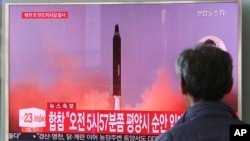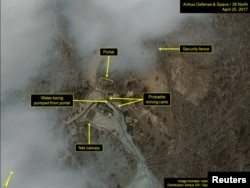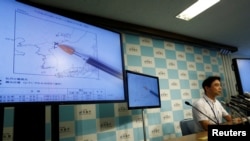North Korea’s main underground nuclear test site may be damaged and portions of it unusable, but analysts say that does not mean Pyongyang can no longer carry out nuclear tests at the facility or elsewhere.
Late last week, North Korean leader Kim Jong Un pledged to halt nuclear and missile tests and to close its Punggye-ri facility. The site has been used for all six of the isolated country’s nuclear tests.
In recent years, the stability of Mount Mantap at the site has increasingly been a concern because of the possibility of radiation leakage. And now news has surfaced regarding two new studies by Chinese seismologists that confirm those concerns.
Study: Test site collapse
According to media reports, scientists in China have found that following North Korea’s latest nuclear test last year, a cavity inside Mount Mantap collapsed. One study said the breakdown of the mountain created a chimney that could allow radioactivity from the blast zone to rise into the air.
A report in the Wall Street Journal this week said the study also warned that any further testing at the site with a similar yield could cause an environmental catastrophe.
Another study that was published this month by several other Chinese scientists came to the same conclusion about the collapse of a cavity at the facility but did not say whether the site was still usable, the Wall Street Journal added.
North Korean analysts say that even if the collapse of parts of the facility happened and if Mount Mantap is unusable, there are other mountains nearby and other tunnels.
Many tunnels
Joseph Bermudez, a North Korean expert with 38North, said the northern entrance at the Punggye-ri facility leads to a series of tunnels that branch off, which is how they have been able to host so many tests at the site.
“Obviously the tunnel that was used for each of the tests is no longer viable but it doesn’t mean that there isn’t another branch that the North Koreans could use,” Bermudez said.
At the site, there are three other entrances. One to the east that was apparently used for North Korea’s first test, another to the south that has not been used and then a portal to the west, he added.
Bermudez said that until last week there was excavation activity at the west portal and right before Kim’s announcement that the facility would be shut down all of the carts were pulled out and lined up in a neat row for satellite surveillance to pick up.
“This is a clear indication that they’re telling us, “Hey, look, we are stopped,’” he said. “As far as we can tell, North Korea’s Punggye-ri facility is ready and capable of conducting another nuclear test anytime Kim Jong Un decides to do so.”
Other mountains
James M. Acton, co-director of the Nuclear Policy Program at the Carnegie Endowment for International Peace, said that even if North Korea cannot use Mount Mantap there are other mountains in the vicinity or elsewhere.
“The decision not to test is a political decision, it is not, I think one forced on North Korea for technical reasons,” Acton said. “This is neither a technically enforced decision nor is it a permanent decision. It would not be difficult to reverse.”
Some have suggested North Korea had little choice but to halt its tests because of mounting pressure from international sanctions and the geological structure of the test site.
Kim’s announcement late last week to close the site, stop tests and focus on opening up the economy is a welcome shift, said professor Steve Tsang, director of the China Institute at London’s School of Oriental and African Studies. But also one that should be approached carefully as the pledges do not amount to much.
“He (Kim) has not put much on the table, he has not said the existing nuclear stock or the longer range nuclear missiles that the North Koreans have are open to negotiations,” Tsang said.
Tsang said that Kim’s pledge to halt tests could be related to the condition of the facility, but also because the North does not have any plans to carry out tests for now, especially with U.S. intelligence agencies and others closely watching the facility.









